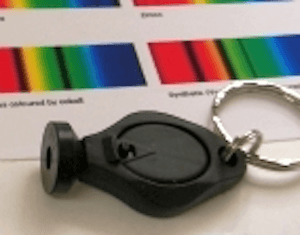Product Review: GL SpectroLite
The GL SpectroLite is an inexpensive and easy-to-use tool that can help gemologists conduct spectroscope exams. Read our review to learn more.
2 Minute Read
Prism vs Diffraction Grating Spectroscopes
Spectroscopes come in two varieties: prism and diffraction grating. Each has its advantages and disadvantages.
Diffraction grating spectroscopes cost less than prism spectroscopes. However, their primary shortcoming is that the display is so dark you can’t get a reading on some stones.
Prism spectroscopes have a brighter display, and some have a calibrated scale. However, their spectrum is spread out unevenly. This makes it hard to read the red end.
Both spectroscopes are difficult to use. Prism spectroscopes have an adjustable light opening and a focusing control. It requires two hands to make these adjustments. To accomplish this, the stone needs to be in a fixed position. Most gemologists also prefer to attach a prism spectroscope to a stand. Diffraction grating spectroscopes are usually handheld. Not having to adjust the focus and light opening simplifies the process, but getting the scope, stone, and light source aligned is a little less easy. You need steady hands and a lot of patience to perform this task gracefully.
Aligning the Spectroscope, Gem, and Light
The most difficult part of using either spectroscope is aligning the instrument with the light coming out of the stone. Light doesn’t pass…
Donald Clark, CSM IMG
Related Articles
Refractometer Guide, Part 3: Determining Optic Character and Recognizing Optic Effects
Product Review: Duplex II and Rayner Dialdex Refractometers
Learn to Use a Refractometer (Video)
Gemology Interactive Media Reviews
Never Stop Learning
When you join the IGS community, you get trusted diamond & gemstone information when you need it.
Get Gemology Insights
Get started with the International Gem Society’s free guide to gemstone identification. Join our weekly newsletter & get a free copy of the Gem ID Checklist!
